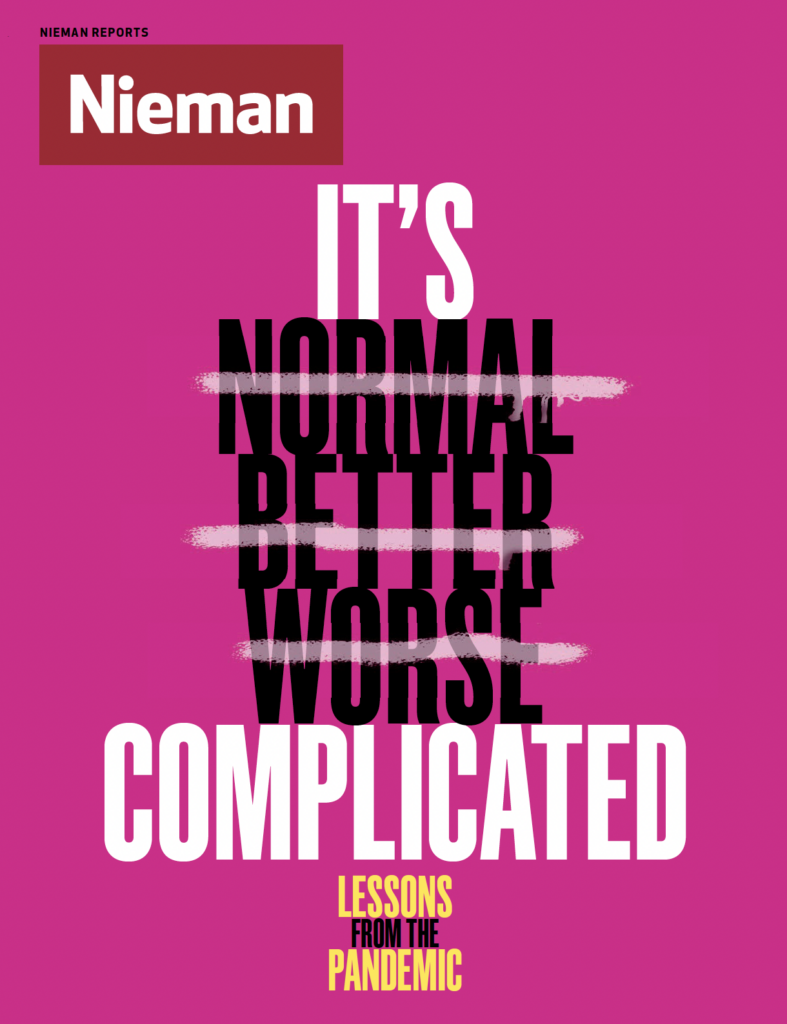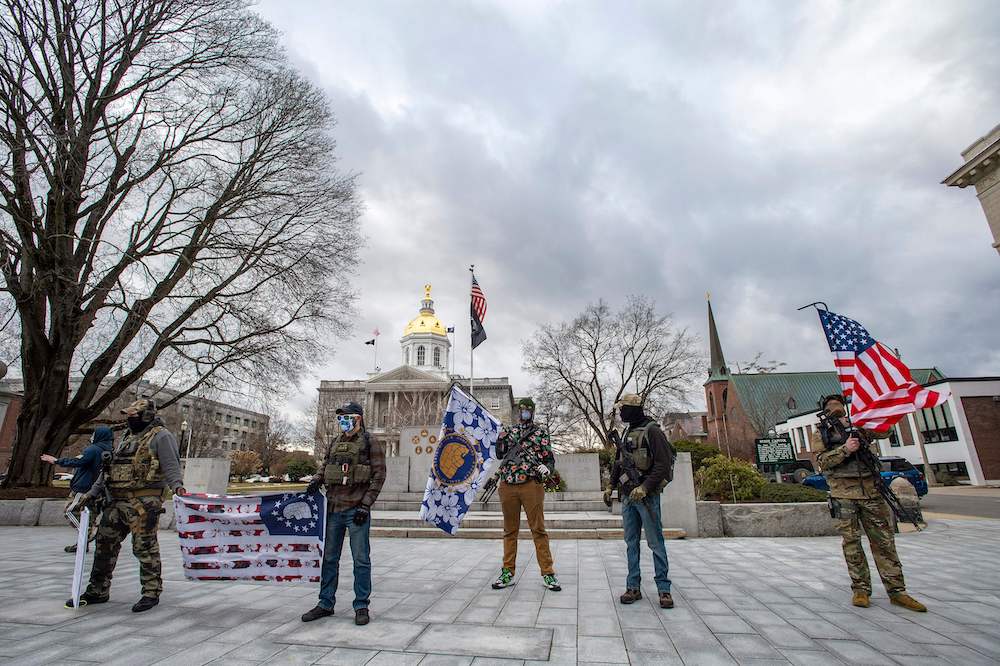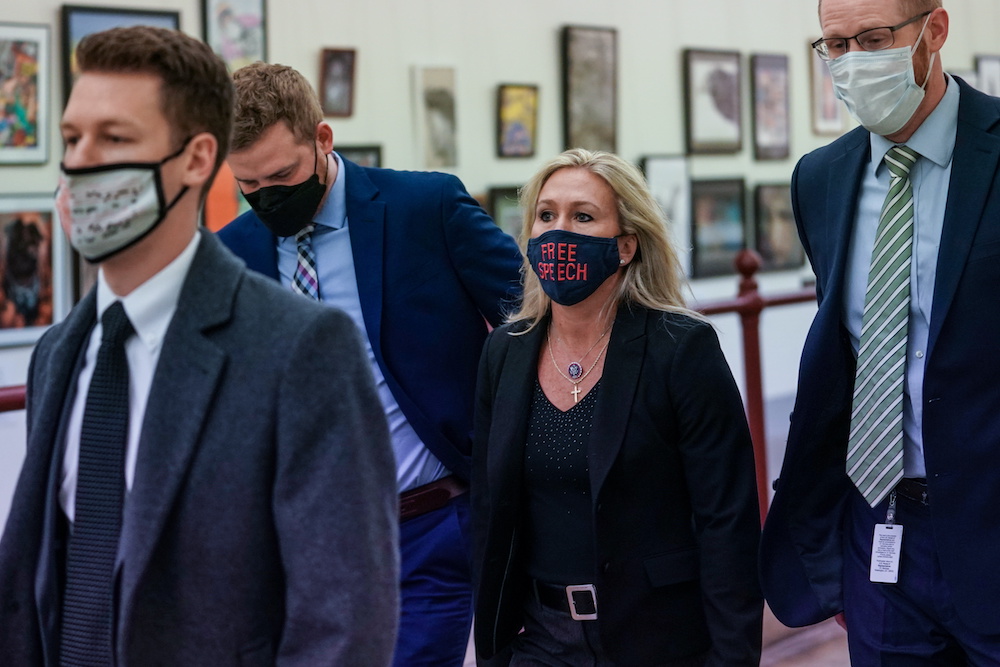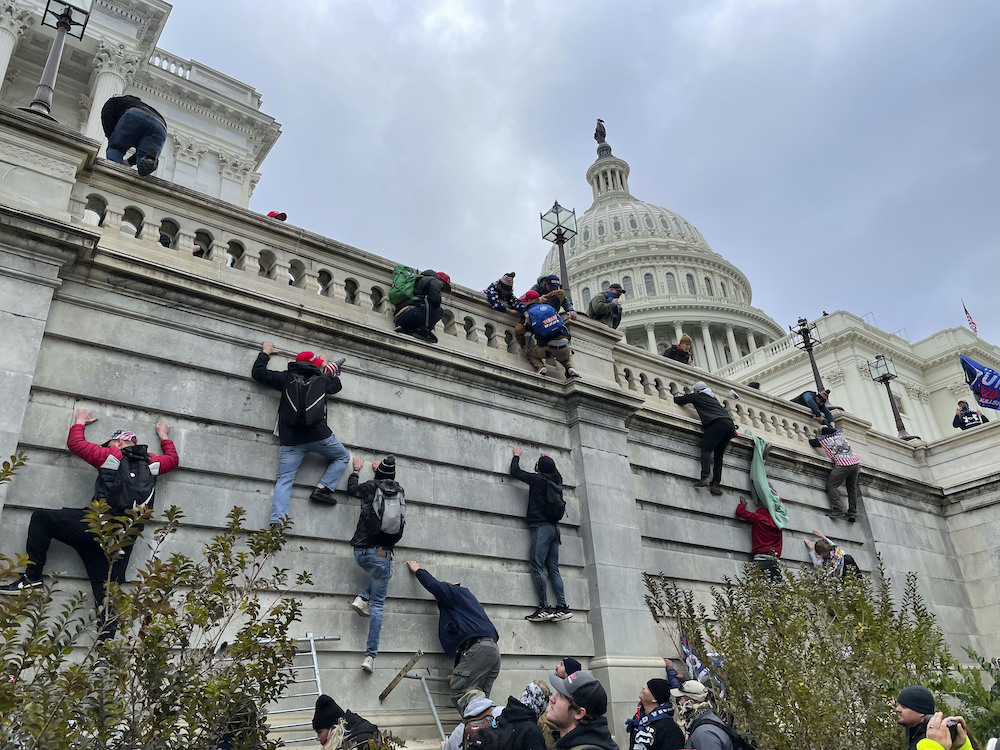
Hope that the coronavirus is finally being brought under control has prompted plans for a return to “normal.” But can, or should, journalism return to a pre-pandemic “normal?” Across newsrooms, the way we once covered education, sports, food, politics — any beat — is unlikely to be sufficient for the new moment we are entering.
What are the lasting lessons of this time? And how should we do journalism differently moving forward? These are the questions Nieman Reports explores in our essay series, Lessons from the Pandemic.
Seyward Darby’s book on women in the white nationalist movement, “Sisters in Hate,” grew out of a detailed piece of reporting she published in Harper’s in 2017. But that wasn’t the first place she shopped the story — and she still remembers the way another outlet greeted the pitch.
“Their reply really bugged me, because it [felt like], ‘You don’t even really need to do much reporting. [Just] find some quotes online and throw together an article basically highlighting how weird this is,’” recalls Darby, who’s also editor of The Atavist Magazine. “At that point, I already saw how poor some of the coverage was of this space and how much of it treated it [as] kind of this ‘crazy thing that’s happening right now,’ as opposed to something that spoke to broader trends in American society. I felt like it was asking me to take [a] stance of dismissiveness.”
Just months after Darby’s book came out in July 2020, an insurrectionist mob stormed the U.S. Capitol to try to thwart certification of Joe Biden’s victory over Donald Trump in the 2020 presidential election. At least five people died because of the riots; two police officers subsequently committed suicide.
Dismissiveness isn’t a tenable stance when it comes to covering white nationalism, conspiracy theories, hate speech, and other forms of extremism. The storming of the Capitol centers what reporters on the far-right beat have been saying for years: America, and its media, need to take this threat seriously.
The question is, how to do so without amplifying misinformation or normalizing extremist ideologies.
Many were shocked by the violence of January 6. Many who have long covered the far right, white nationalism, and conspiracy theories were decidedly not.
“These groups were underestimated for way too long,” says Melissa Gira Grant, a staff writer for The New Republic who has written extensively about the far right. “And part of the way they were underestimated is, we just thought that’s not who we were … Who would fly a Confederate flag in the Capitol? … That’s the thing that’s sort of shifted; [what] people will understand as ‘possible’ is just different now.”
Dismissiveness isn’t a tenable stance when it comes to covering white nationalism, conspiracy theories, hate speech, and other forms of extremism
Extremists have been dismissed and their threat minimized by portrayals as lonely basement-dwellers spouting impotent hatred in chat rooms. They have coded their violent intent in goofy cartoon imagery and flowery clothes. Some news outlets initially avoided or limited coverage of militant groups for fear of giving them oxygen to flourish. At times, efforts to expose malignant forces have backfired, either because those forces were normalized or quasi-glamorized or because the people who wrote about them unintentionally ended up being vectors for publicity and even recruitment.
Reporters who covered extremism, white nationalism, conspiracy, and militant activity before January 6 have some advice, warnings, and outstanding questions about where reporting goes from here.
Learning the lessons of the last war
When it comes to the political animus that started swirling around former President Donald Trump when he was still a candidate, Evan Osnos, a staff writer for The New Yorker based in Washington, notes there were precursors. Trump “was the culmination of decades of decisions in economics and politics and media,” Osnos says. As a reporter, he saw some of this for himself on the campaign trail and flagged it. Scarcely two months after Trump declared his candidacy, Osnos had a New Yorker piece noting the reality TV star’s appeal to white nationalists; the story quoted a web developer praising a Trump debate performance while “sipping coffee from a cup adorned with a swastika.”
Now, Osnos senses that outlets are less inclined to pull punches for fear of being seen as partisan. “It’s not a big-D Democratic thing to say that [Missouri Republican Senator] Josh Hawley provided essential support, ideologically and rhetorically, to the events that unfolded on January 6 — full stop. [That’s] a statement of fact,” he says. “I sometimes think of journalism practices [as] learning the lessons of the last war, always.”

Coverage of Hawley, Osnos says, can underscore “the lessons of the early Trump era when people were more or less assuming that Trump was either temporary [or] not a serious political element.” A younger generation of journalists in particular is wary of conventional euphemisms, he suggests. A late February Time story on the annual Conservative Political Action Conference, for example, cut straight to noting that “Hawley wore his involvement in the insurrection as a badge of honor.”
American University’s Kurt Braddock, an expert on communication related to extremism, thinks the media has largely self-corrected on how it covers dangerous domestic ideologies. That included a shift from merely reporting the existence of the QAnon conspiracy theory to actively debunking it as “adherents began getting a bit too dangerous,” he says. “Without indicating that the disinformation being reported on has no evidence to back it up, it tacitly suggests that the disinformation may have merit.”
Reporter after reporter also expressed a related concern: that the media is waving a flag about extremism, but decision-makers have been slow to react. Power brokers up to and including then-President Trump have also repeatedly been called out for refusing to disavow QAnon and risk alienating members of their political base.
It “sometimes feels like the right people are not paying attention,” says Vice reporter Anna Merlan. “If they’re not concerned after these people break down the doors to their place of work, I don’t know what it’s going to take.”
Merlan is among the reporters to have documented how hate movements metastasized long before January 6. In her 2019 book, “Republic of Lies,” she described in detail a 2017 white nationalist cookout in Kentucky that preceded the deadly “Unite the Right” rally in Charlottesville that same year; many extremist figures attended both events. “There is this really persistent ‘Just ignore it and it’ll go away’ kind of sentiment a lot of times about white supremacy [and] virulent conspiracy theories,” Merlan says. “It doesn’t go away. Sometimes it gets elected to Congress.”
Substance over style
Part of the reason more outlets are emphasizing that radical beliefs among certain groups aren’t a wacky fringe phenomenon? Those beliefs aren’t “fringe” anymore, as pointed out in a recent NPR report on the three-fifths of white evangelicals who are convinced President Joe Biden’s election wasn’t legitimate.
But just because beliefs aren’t “fringe” anymore doesn’t mean they should be normalized. Reporters consistently point to coverage of alt-right leader Richard Spencer as a great example of where the press could have been more careful about early portrayals of the standard-bearers of hate movements.
The Southern Poverty Law Center’s profile of Spencer calls him “a suit-and-tie version of the white supremacists of old, a kind of professional racist in khakis,” whose “clean-cut appearance” has obscured his dark goal: Establishment of a white ethno-state.
The media is waving a flag about extremism, but decision-makers have been slow to react
Some reporters who specialize in documenting hate fear that some of what’s been published about Spencer played into his efforts to draw people to his racist cause. “Let’s Just Stop Writing Long-Form Profiles of Nazis,” pleaded a 2017 piece in Current Affairs by Nathan J. Robinson, calling out coverage of Spencer in major outlets from The Washington Post to Mother Jones to Politico. Robinson argued that these kinds of stories get done partly because virulent racists say vile, incendiary things to get media attention – and it works.
“I think these people, to a certain extent, view the press as marks and are working us. As much as they hate us, they’re working us,” says Gira Grant of The New Republic.
The fact that Spencer is highly educated and couches his hateful beliefs in an articulate way is something “a lot of people would say in hindsight gave him a platform and lent him legitimacy, when the focus should have been [on] his rhetoric and his system of beliefs,” agrees Molly Boigon, whose beat at The Forward includes investigating anti-Semitic extremism. “I think that the early coverage of Richard Spencer probably endeared him to people who otherwise wouldn’t have known he existed.”
By comparison, a 2016 item in The Cut chose not to simply highlight the fashion sense of white nationalists as part of a larger profile, but focused specifically on how style was being used to dress up racial animus in a more mainstream way. It wasn’t the only story of that genre, but a useful example of a practice that extremism reporters consistently recommend: Move as directly as possible to expose the misleading or harmful practices of those spreading or acting on hateful ideas.
Bring light, not oxygen
To that end, journalists versed in covering the far right say technique is key. Darby, author of the book about women in extremist movements, puts it this way: Coverage of hate is about “shining a light, but positioning the light in the right way.”
That’s particularly vital in terms of another argument about far-right coverage that often crops up. Maybe we shouldn’t be covering this stuff at all, because we’re just becoming a megaphone for hate groups and, worst case, a recruitment tool. If “you — meaning somebody in the mainstream media — aren’t casting a very bright, well-positioned light, that just means that they’re going to be able to share their information unfiltered and people are going to access it,” says Darby.
Joan Donovan and danah boyd, who have explored technology’s relationship to bias for the nonprofit Data & Society and elsewhere, have argued for “quarantining” hate speech through “strategic silence” — including by reporters not covering it. A familiar example would be a paper refusing to run an inflammatory letter to the editor, making a choice about what voices to amplify and which to deny a platform. Some outlets, including The New York Times, have found themselves on the defensive after readers reacted poorly to coverage they felt went too far in “normalizing” hate.
As Merlan, the “Republic of Lies” author who specializes in exposing conspiracy-fueled activity for Vice, sees it, “The one thing that we keep finding out is that the line between coverage and amplification is thin — but it’s not as thin as some people would have you believe. The idea of not covering these movements at all, to me, doesn’t seem like an option given how influential they are in our world.”
The reporting approach therefore centers on what effects these beliefs are having and how they move through social media and other information ecosystems. “I try not to focus a ton on, ‘Here is the latest crazy thing that QAnon or the anti-vax movement [is] promoting,’” says Merlan.
“It’s more like, ‘Okay, they’re promoting this belief. To what end? What are they selling? What are they trying to do with it? Who’s signing on to it?’” she says. We’ve spent a lot more time thinking about money than we do about the contents of the [false] beliefs themselves.” There’s crossover between the anti-vax and political conspiracy worlds, and Merlan has written about how the promotion of dangerous fringe “supplements” kicked up after Trump mused about using internal disinfectants against coronavirus, for example.
Decisions about what to cover — and what to monitor but not publish — are part of a calculation that a growing cadre of extremism reporters have to make all the time.
“There’s something called a ‘tipping point’ that everybody on this beat has long used [to] move from just watching far-right spaces, watching conspiracy spaces, watching extreme spaces and then writing about it,” says NBC News reporter Brandy Zadrozny, who was covering extremism long before January 6. That point might come when a dangerous theory escapes a small echo chamber or is amplified by an influential person. Another tipping-point moment: When extreme ideas or theories start to result in physically dangerous behavior — such as bleach consumption to combat coronavirus — even among a fairly small slice of the population.
Journalists versed in covering the far right say technique is key
The political and social unrest of 2020 made the tipping-point calculus even more important because of the sheer volume of news that had to be monitored. “Disinformation was being seeded by the president of the United States and feeding extremists and hate groups, [and] wrapping back around through this feedback loop,” Zadrozny recalls. “We were seemingly just trying to explain to a large portion of the country, ‘What are these people talking about? Why is it important to know [and] how does it threaten democracy?’”
Zadrozny, for one, says even radical events have not changed how she makes those news judgments. In her case, she puts the story “on an imaginary scale.” On one side, she weighs the public benefit of reporting something, such as whether it changes policy, holds the powerful accountable, or elevates “marginalized voices.” The benefits have to outweigh the potential harms, such as amplifying lies or mainstreaming extreme thought. Another consideration: Whether the reporting exposes something previously hidden. As an example, Zadrozny points to her work on revealing “the way anti-vaccination activists use Facebook to spread distorted stories of dead children and [to] recruit.”
Trump being out of office and deplatformed from outlets like Twitter and Facebook will shrink that echo chamber, not eliminate it. “People [make] money off of this ecosystem, so they’re not just going to go away,” Zadrozny says.
Reporters who cover the far right must still vigilantly monitor these breeding grounds, including a proliferation of newer platforms, like Rumble, Gab, and MeWe. They don’t always have to publicly highlight them, though. Zadrozny: “There’s still a lot of talk; they’re just not given a megaphone.”
Focus on people adjacent to the problem
When something does rise to the level of a story, reporters versed in extremism use some common guideposts in their coverage.
Right off, it’s worth knowing the media can’t and won’t fix everything. There are inherent problems with believing even hyperaggressive coverage of figures like Marjorie Taylor Greene, the QAnon supporter elected to Congress from Georgia in 2020, must naturally lead to their rejection, says Lawrence Rosenthal, chair of the Berkeley Center for Right-Wing Studies and author of “Empire of Resentment: Populism’s Toxic Embrace of Nationalism.”
University of Cambridge researchers have found that people who hold extremist beliefs both viewed the world in black and white absolutes and had more trouble processing evidence and doing complex mental exercises. So, debunking might not always work.
In the case of Taylor Greene, Rosenthal says, the kind of people likely to cleave to her brand of politics may already be on her side, and not in the audience of mainstream outlets that provide critical coverage. What if, he asks, more coverage of Taylor Greene’s ideology had resulted in her not losing her congressional race, but winning by an even bigger margin? “The assumption that [more reporting on] ‘Here’s what she is, and here’s what she stands for’ would have diminished her vote, I’m not sure that’s right… It may have had the opposite effect,” he says.
Chris Jones, an investigative reporter for 100 Days in Appalachia and a Report for America corps member, says being keenly aware of his audience is a major factor. Recently, he wrote about how local reporters are left holding the bag for national coverage that centers white extremists, not the havoc they wreak. For the local reporter covering extremism, parachuting in and finger-pointing is neither useful nor possible.

Instead, Jones says, there are other ways to have impact. One 100 Days piece, for example, asked, “What is QAnon and Why Does Your Aunt Keep Posting About It On Facebook?” The point: To focus on people adjacent to the problem who might be confused, worried, or vulnerable, rather than give conspiracy believers the spotlight.
While Jones quickly acknowledges that as a bearded, six-foot-tall, white male Afghanistan combat vet, he can interact more easily with militia-types than others, he doesn’t make a point of covering them gratuitously. In a segment with Reveal’s “United, We’re Not” podcast, he focused his coverage on a Black West Virginia lawmaker targeted by hate purveyors; the voices of the haters were, literally and figuratively, in the background.
Call racism and xenophobia exactly what they are
Covering militia and hate groups can mean reporters eschewing close contact or attempts to seem even outwardly accepting of vitriolic views or speech. When dealing with the women she spotlighted in “Sisters in Hate,” Darby says she never attempted to come across as open to their supremacist views; she just explained she was trying to get their cooperation to understand how they had embraced those viewpoints.
“You, as the writer, do have to be something of a counterweight to what you’re reporting on,” she says. “Certainly, I was trained in the school of objectivity and letting things speak for themselves and letting the reader decide … [Those] rules can’t apply here, because there are moral rights and wrongs. And beyond that, there are facts and lies.”
When reporting the material in her book, Darby “didn’t try to infiltrate anything; I didn’t have like an identity that was meant to be sympathetic.” If that cost her access to sources, she was ready to accept it. Also, Darby made a pact with herself not to engage in fruitless arguments with white nationalists. “I just kept asking questions and I found [that], at least for me, was a productive way of doing it.” She also made sure to carve out time for human interactions outside the bubble of hate.
Always calling racism and xenophobia exactly what they are, Darby and others agree, is essential. How reporters get to those stories can vary.
One approach Boigon has taken at The Forward is telling the stories of people who once espoused hateful or conspiracist thought, but ultimately rejected it. “It’s [like] seeking out former employees of a company. They know what’s going on, and [they’re] freer to talk about it,” she says. Plus, “If you have somebody talking about a system of beliefs in a more critical way, it probably turns fewer people onto those ideas than somebody who’s in the throes of it and is trying to recruit participants and might be using a reporter to push that message.”
A February piece on Melissa Rein Lively, a former QAnon adherent whose 2020 anti-mask tantrum in a Target store went viral, also fit Boigon’s mission. The Forward story focuses more than other accounts on Lively’s Jewish upbringing and includes strong messaging about how she got caught up in – and disentangled herself from – the QAnon web.
As a matter of practical craft, Boigon adds, “Any time I’m repeating a claim that conspiracy theorists or white nationalists are making, I try and make it as clear as possible that it’s without merit or without evidence. [I] also imagine that that would prevent [the reporting] from being taken out of context, by either bad actors or people who just don’t know any better.” This is where media critics heavily suggest the “truth sandwich” approach, which relies on emphasizing what is true, not what isn’t.
As they work, reporters in this arena take steps to protect their safety and well-being. They scrub personal and family information from the web and make thoughtful choices about communicating via email or texts, which can be screenshot and broadcast. Setting up reference files of research on hateful content helps limit traumatic return trips to sinister web outposts.
People (and reporters) of color and immigrants have long been aware of the threats posed by domestic hate groups. Observers have noted differences in political — and media — responses to foreign and domestic threats, and the danger of applying double standards to political activity and speech by whites and non-whites.
Farai Chideya, a longtime political reporter and host of the “Our Body Politic” podcast, talks candidly about having gotten pushback over covering “weaponized racial resentment” as a pivotal factor in the 2016 election. “I think that there’s this widespread erroneous perception that Black reporters are not objective and that somehow we’re out to protect the Black race,” she says. “Let me tell you: I would much rather, based on the political reporting of the past five years, base my reality on what the Black reporters are saying … it’s just closer to reality.”
Decisions about what to cover — and what to monitor but not publish — are part of a calculation that a growing cadre of extremism reporters have to make all the time
Among others, Chideya points to Astead Herndon of The New York Times for delivering “culturally competent reporting, [including] with white people who clearly have no particular love for being in a multiracial nation.” She points to Herndon’s detailed piece on a 2019 “Trumpstock” gathering, where he quoted a participant predicting “nothing less than a civil war” if the president should lose his re-election bid. “It wasn’t prejudicial, but it let you know what themes were woven into the self-defined culture of this group,” Chideya says.
More broadly, Chideya says organized white supremacy has been undercovered for many reasons. Some whites are “profoundly uncomfortable” with categorizing whiteness as a race the same way Blacks, Latinos, or Asians are covered, or with writing about white and minority issues with an equally critical eye. Others try to argue that white extremism is too small of a phenomenon to merit much coverage at all. “Wrong,” says Chideya.
To that end, FiveThirtyEight’s Perry Bacon Jr. says it’s vital to get clarity “on the idea that identity and how it shapes politics is not just a story about minorities.” In a recent piece about what the Trump era taught him about covering politics, Bacon made “Listen more to Black people” the first item on his list.
When it comes to covering the post-January 6 world, says the New Yorker’s Osnos, “We’re going to have to be as determined to figure out the ideological origins, no matter where they lie, as we were after 9/11. That is going to be uncomfortable for a lot of people, because it’s going to mean understanding the role of powerful institutions in this country, including the police and Department of Homeland Security and Christian nationalism and other things that have really not been subject to the same level of scrutiny.”
Extremism is as exhausting a beat as it is important, and Seyward Darby readily admits there are days she wouldn’t mind covering something else. But when it comes to the far right, that’s just it: “They count on the fact that [we’re] going to get bored, are going to get tired. We’re going to move on. This is why the sustained shining of [a] well-positioned light is important, because they’re going to keep doing what they’re doing,” she says.
“We should not let them have that opportunity.”



